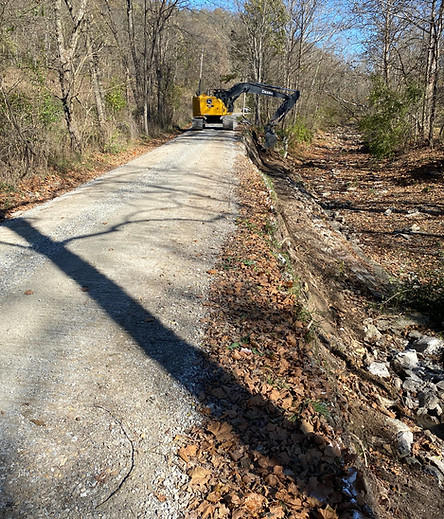Gallery
In the dynamic realm of geotechnical construction services, where innovation meets structural prowess, the dedication of our people has led to a portfolio of successful projects & elated clients.

Check out the
Geo Specialties
Blog,
"Earth Craft!"
Geotechnical Construction in ’25: Embracing Sustainability.
This year the geotechnical construction industry is at the forefront of revolutionizing infrastructure development. With the increasing demand for resilient and sustainable infrastructure, professionals in the field are leveraging cutting-edge technology and sustainable practices to address complex challenges. From urban megaprojects to renewable energy installations, geotechnical construction is reshaping how we interact with the built environment. Among the most promising trends is the integration of advanced geotechnical monitoring systems that utilize IoT sensors and real-time data analytics. These tools provide unparalleled insights into soil behavior and structural stability, enabling engineers to make informed decisions and reduce project risks.
Sustainability has become a critical focus for geotechnical construction, driving the adoption of eco-friendly techniques and materials. Innovations such as soil bioengineering, which uses vegetation to stabilize slopes, and recycled construction materials are becoming mainstream practices. Additionally, the emphasis on reducing the carbon footprint of projects has spurred the use of low-carbon cement alternatives and renewable energy sources for construction operations. Governments and private stakeholders are increasingly mandating sustainability metrics, ensuring that projects align with global climate goals. These developments underscore the role of geotechnical engineers as stewards of both the natural and built environments.
Looking ahead, the fusion of artificial intelligence (AI) and geotechnical engineering promises to unlock new possibilities. Predictive modeling powered by AI is revolutionizing project planning, allowing for the simulation of various scenarios and their potential impacts on soil and structures. This capability not only enhances safety but also optimizes resource allocation, saving time and costs. As cities continue to expand and climate change intensifies, the geotechnical construction industry must adapt and innovate. By embracing sustainability and technological advancements, the industry will play a pivotal role in building a future that is both resilient and sustainable.
Come back soon to see what's new with Geo Specialties!

At GeoSpecialties, we are excited to be at the forefront of this movement.
In today's rapidly evolving world, innovation is not just a buzzword — it's a necessity. Geotechnical engineering and construction are no exceptions. The fields that form the bedrock (literally and figuratively) of infrastructure development are undergoing a dynamic transformation fueled by technological advancements, sustainability demands, and creative problem-solving. At GeoSpecialties, we are excited to be at the forefront of this movement.
-
Advanced Site Characterization Traditional soil boring and testing methods are being enhanced by geophysical surveying techniques, remote sensing, and real-time data acquisition systems. Technologies like LiDAR, ground-penetrating radar, and UAV-based surveys provide more detailed subsurface information faster and more cost-effectively than ever before.
-
Smart Materials and Systems Geotechnical construction is embracing materials that respond to their environment. Innovations like self-healing concrete, geosynthetics with built-in sensors, and adaptive foundation systems are creating structures that monitor themselves and extend their own lifespans.
-
Automation and Robotics Autonomous drilling rigs, automated grading systems, and robotic shotcrete applicators are minimizing human risk and increasing precision. These technologies are revolutionizing how we approach challenging terrains and difficult environments.
-
Data-Driven Decision Making The integration of big data and artificial intelligence allows engineers to predict ground behavior with greater accuracy. Machine learning models help optimize designs, assess risks, and enhance quality control throughout construction phases.
Sustainability & Resilience: Innovation in geotechnical engineering is also heavily focused on sustainability. Techniques like soil bioengineering, use of recycled materials, and ground improvement methods that reduce the need for resource-intensive solutions are gaining traction. In addition, resilient design principles are ensuring that projects can withstand not only current conditions but also the uncertainties of a changing climate.
The Human Element: Creativity Meets Engineering: While technology is a powerful enabler, innovation fundamentally stems from people. Engineers and constructors who think creatively, challenge conventional practices, and adapt to new information drive the industry forward. At GeoSpecialties, we empower our teams to combine technical rigor with imaginative thinking to deliver groundbreaking solutions.
Looking Ahead: The future of geotechnical engineering and construction is bright, with possibilities limited only by our willingness to embrace change. As we continue to leverage new technologies, prioritize sustainability, and nurture creativity, we are building not just better structures, but a better world.
Conclusion: Innovation is reshaping the way we understand, interact with, and build upon the ground beneath us. At GeoSpecialties, we are proud to lead with vision and expertise, turning today's challenges into tomorrow's achievements.
Stay tuned to our blog for more insights into how we are pioneering the future of geotechnical engineering and construction!
Emerging Technologies Redefining the Industry








